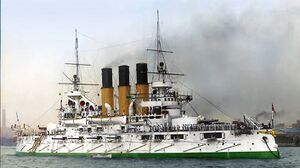Sundering Naval Arms Race

The Sundering Naval Arms Race occurred between the Republic of Syara, the Ruvelkan Socialist Republic, and the Republic of Górska in the late 19th and early 20th Century, beginning with the modernization of the Navy of the Syaran Republic in the 1880s and ending with the Third Chryse War in 1909.
The Unification of Syara had upset the balance of power in north-west Siduri that had existed for much of the 19th Century following the demise of the Rioni Union. Whereas the various Syaran Successor States had vied for power and influence with both Ruvelka and Górska, the newly unified Republic boasted an economic, political, and military might that swung the balance in Syaran favor. The already alarming development was further augmented by the decision of the Syaran Admiralty to pursue a fleet of large, capable capital ships and a flexible fleet of cruisers, torpedo boats, and coastal craft that would surpass the navies of both Górska and Ruvelka. Although originally envisioned just as a means of national defense, the Syaran Navy began pursuing more overt actions and construction to achieve naval superiority over its neighbors. While the naval arms race is considered to have initially started in 1886 with Syaran announcement of their plans for a new fleet, it was the production of the Nemaro-class battleships that largely kicked off the naval development in both Górska and Ruvelka.
Unable to construct large capital ships on their own, Górska turned to foreign assistance from Ossoria, who helped produce the Opolski, Jarosz, and Rykowksi-class battleships. Górskan naval yards focused heavily on the production of smaller ships, namely coastal battleships and similar defense craft, while cruisers were built with assistance from Acrea. The Federal Navy further built frigates, which were essentially torpedo boat destroyers, as well as torpedo boats. By the start of the Chryse War, Górskan Federal Navy consisted of 8 ocean-going battleships, 14 ironclad warships, 23 coastal battleships, 12 cruisers, 21 frigates, 53 torpedo boats, and 12 sloops.
The Ruvelkan Red Navy however, lacking both infrastructure and resources, struggled to achieve naval parity with either Syara or Górska. The Tatabánya-Class Cruisers were Ruvelka's most proficient native design, but any larger ships were effectively beyond Ruvelkan capacity to construct. Ruvelkan difficulties were partially overcome with the assistant of a renegade Cacertian naval officer, Captain Ninnia Regula, who provided technical information on the HMS Serena Waterly to the Ruvelkans, which was utilized to construct the largest Ruvelkan ship made by the Socialist Republic, the battlecruiser Khoytka . Despite an impressive design on paper, production was hampered by high costs and inexperience; out of a planned class of four, just one was ever finished.
In spite of significant investment (naval spending consumed 40% of the Górskan federal budget, on average, between 1890 and 1900), Górskan and Ruvelkan shipyards could not match the output of Syara's 73 shipyards and nearly 250 hulls a year. By 1904, the Syaran Navy (MRS) possessed 14 battleships, 22 cruisers, 48 torpedo gunboats (from hereon referred to just as "destroyers"), 73 torpedo boats, 13 coastal defense ships, 9 monitors, and 12 gunboats. To complicate matters further, the introduction of the HMS Serena Waterly had ushered the world of warships into the era of dreadnoughts, effectively rendering all pre-dreadnought battleships obsolete. While Ruvelka was able to complete its battlecruiser Khoytka in accordance with the most recent technological developments, the Górskan government found itself unable to afford the construction of an entirely new and expensive type of battleship. Zovahr's announcement of the Republic's own dreadnought design, the Syara-class, effectively ensured Syaran naval supremacy in the Sanguine and Sundering Seas unless action was taken. Fears of the impending and complete shift in power towards the Syaran Navy was a major factor in driving the Ruvelkan and Górskan governments to make war.
Naval warfare in the Third Chryse War was extensive and served as the last major clash of pre-dreadnoughts, but the introduction of the Syara-class, couple with Syaran numerical superiority, allowed Syara to gain major victories at sea. Despite highly trained crews and capable captains, alongside legendary performances from ships such as the SMF Zuzanna, the fighting on Chryse forced the Górskan navy to face open battle with the Syaran fleet, which by 1908 had culminated with the destruction of much of the Górskan fleet at Kalikie. Although the Khoytka performed well in the war, the Battle of Mátészalka crippled Ruvelkan efforts to support the Górskan navy, and by the end of the war both fleets had surrendered control of the open sea to the Syarans.
Syaran victories at sea had not translated to victory on land, and the war ended by most counts as a Syaran defeat as the Republic was forced to cede half of Chryse, and much of Zemplen. Despite this, the balance of power in naval matters remained firmly in Syaran hands, and would remain so in the decades that followed. Syara's "victory" in the naval arms race was widely credited to its deployment of dreadnought battleships before either Ruvelka or Górskan, and its ability to produce larger numbers of warships. Many historians now hold that the focus placed on the role of dreadnoughts in the naval arms race and the Chryse War overshadowed the even more significant advances in torpedoes, destroyers, and offensive naval mining that the Syaran navy employed, and would later utilized to significant effect in the Divide War.